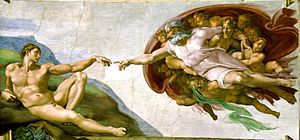Renaissance art facts for kids
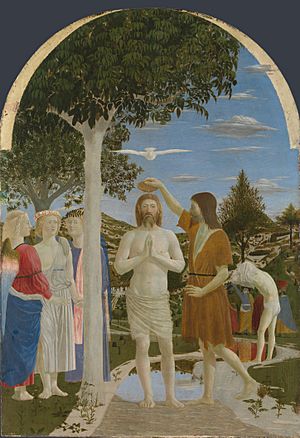
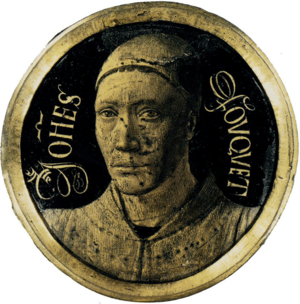
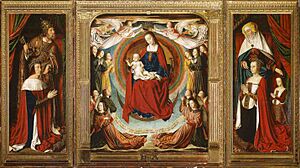
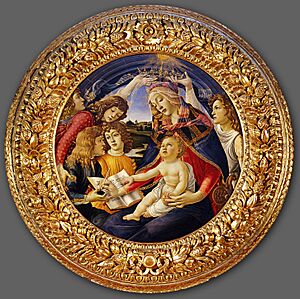
Renaissance art is a special kind of art from a period in European history called the Renaissance. Many of the world's most famous and beautiful artworks were made during this time. The Renaissance started around 1400 and continued until about 1600. Italy, especially the city of Florence, is known as the birthplace of Renaissance art.
Contents
What Was the Renaissance?
The word "Renaissance" comes from a French word that means "rebirth." And that's exactly what it was! After a long time called the Middle Ages (from about 500 to 1400 AD), Europe saw a huge burst of new ideas in art, science, and learning. It began in Italy in the 1300s and then spread across Europe over the next few centuries. Imagine waking up from a long nap and suddenly having tons of new energy and brilliant ideas!
Why Did It Start in Italy?
Italy was very important to the Renaissance for a few reasons:
- Ancient Roman Ruins: Italy was once the center of the Roman Empire. Many amazing old buildings and sculptures were still standing. Artists could study these ancient masterpieces and learn from them.
- Wealthy Cities: Instead of one big kingdom, Italy had many independent city-states like Florence, Venice, and Rome. These cities became very rich from trade and banking. This wealth allowed them to pay for grand art projects.
- Patronage: Important and wealthy people, called patrons, supported artists. These patrons included rich families like the Medici family in Florence, or even the Pope in Rome. They ordered artworks, giving artists jobs and the money they needed to create.
Cool Features of Renaissance Art
Renaissance art is famous for several key things:
- Realism: Unlike art from the Middle Ages, which often used symbols and didn't always look like real life, Renaissance artists wanted their art to look incredibly real. They studied human anatomy, perspective, and light to make their paintings and sculptures seem alive.
- Perspective: Renaissance artists became masters of perspective. This is a clever way to show depth and distance on a flat surface, making paintings look three-dimensional. It was a huge step forward in art!
- Humanism: This was a way of thinking that focused on human potential and achievements. Renaissance art often celebrated human beauty, intelligence, and feelings. Artists didn't just paint religious scenes; they also created portraits, landscapes, and stories from mythology.
- Classical Influences: Artists looked back to ancient Greek art and Roman art and buildings for ideas. They loved the beauty and balance of classical art and used those styles in their own work.
Famous Renaissance Artists
- Leonardo da Vinci (1452-1519): Leonardo was probably the most famous Renaissance artist and a true genius. He was a painter, sculptor, architect, musician, scientist, inventor, and writer. His most famous painting is the Mona Lisa, known for its mysterious smile. He also painted The Last Supper, a dramatic scene of Jesus' final meal.
- Michelangelo (1475-1564): Michelangelo was a master sculptor, painter, architect, and poet. His most famous sculpture is the David, a lifelike statue of the biblical hero. He also painted the amazing ceiling of the Sistine Chapel in Rome. This huge fresco (painting on wet plaster) shows scenes from the Book of Genesis and took him years to finish.
- Raphael (1483-1520): Raphael is known for his beautiful and balanced paintings. His School of Athens, a fresco showing famous philosophers, is a great example of Renaissance perspective. He also painted many stunning Madonnas (paintings of Mary, the mother of Jesus).
Stages of the Renaissance
The Renaissance didn't happen all at once; it changed over time:
- Early Renaissance (around 1400-1490): Artists started to move away from the older Medieval style. They focused on realism and rediscovered classical art techniques. Think of this as the first steps towards a new way of making art. Important artists included Giotto, Masaccio, and Donatello.
- High Renaissance (around 1490-1527): This was the peak of Renaissance art. Leonardo da Vinci, Michelangelo, and Raphael were creating their masterpieces during this time. It was like the golden age of Renaissance art, with the best artists at their most creative.
- Late Renaissance/Mannerism (around 1520-1600): Artists began to try new styles, moving away from the strict realism of the High Renaissance. Mannerism often featured stretched-out figures, unusual perspectives, and a more emotional look. Think of it as a cool, experimental phase of art. Artists like Titian, El Greco, and Tintoretto were important here.
Beyond Italy: Art in Other Countries
The Renaissance wasn't just in Italy. It spread to other parts of Europe, creating different regional styles. Artists in northern Europe, like in Flanders (today's Belgium and Netherlands), Germany, and France, also used Renaissance ideas. However, their style was often different from Italian art. They were known for very detailed pictures of nature and everyday life. They also used oil paints, which allowed for richer colors and more detail. Famous artists from these areas include Jan van Eyck, Albrecht Dürer, and Hieronymus Bosch.
Art Techniques Used
Renaissance artists developed and perfected many techniques:
- Proportion and Perspective: Artists learned how to make paintings look like a window into a real space. This idea started with Giotto di Bondone and was later made formal by Filippo Brunelleschi and Leon Battista Alberti. It helped make art look much more realistic.
- Foreshortening: This technique makes objects or parts of a body look shorter than they are to create an illusion of depth. For example, a foot pointing towards you might look shorter but still realistic.
- Sfumato: Coined by Leonardo da Vinci, sfumato means blurring or softening sharp lines. Artists used thin layers of paint to blend colors and tones smoothly, making things look misty or smoky. This gave a sense of depth and realism.
- Chiaroscuro: This term comes from Italian words for "light" (chiaro) and "dark" (scuro). It's a painting technique that uses strong contrasts between light and dark areas. This creates a dramatic effect and makes objects look three-dimensional.
List of Renaissance Artists
- Leonardo da Vinci (1452–1519)
- Michelangelo (1475–1564)
- Raphael (1483–1520)
- Sandro Botticelli (c. 1445 – 1510)
- Donatello (c. 1386 – 1466)
- Jan van Eyck (1385?–1440?)
- Albrecht Dürer (1471–1528)
- Hieronymus Bosch (c. 1450 – 1516)
- Titian (c. 1488/1490 – 1576)
- El Greco (1541–1614)
Famous Renaissance Artworks
- Ghent Altarpiece, by Hubert and Jan van Eyck
- The Arnolfini Portrait, by Jan van Eyck
- The Descent from the Cross, by Rogier van der Weyden
- Flagellation of Christ, by Piero della Francesca
- Spring, by Sandro Botticelli
- The Last Supper, by Leonardo da Vinci
- The School of Athens, by Raphael
- Sistine Chapel ceiling, by Michelangelo
- The Ambassadors, by Hans Holbein the Younger
- Melun Diptych, by Jean Fouquet
Major Art Collections
You can see amazing Renaissance art in museums around the world:
- National Gallery, London, UK
- Museo del Prado, Madrid, Spain
- Uffizi, Florence, Italy
- Louvre, Paris, France
- National Gallery of Art, Washington, USA
- Metropolitan Museum of Art, New York City, USA
- Vatican Museums, Vatican City
Related Topics
|
See also
 In Spanish: Arte del Renacimiento para niños
In Spanish: Arte del Renacimiento para niños



